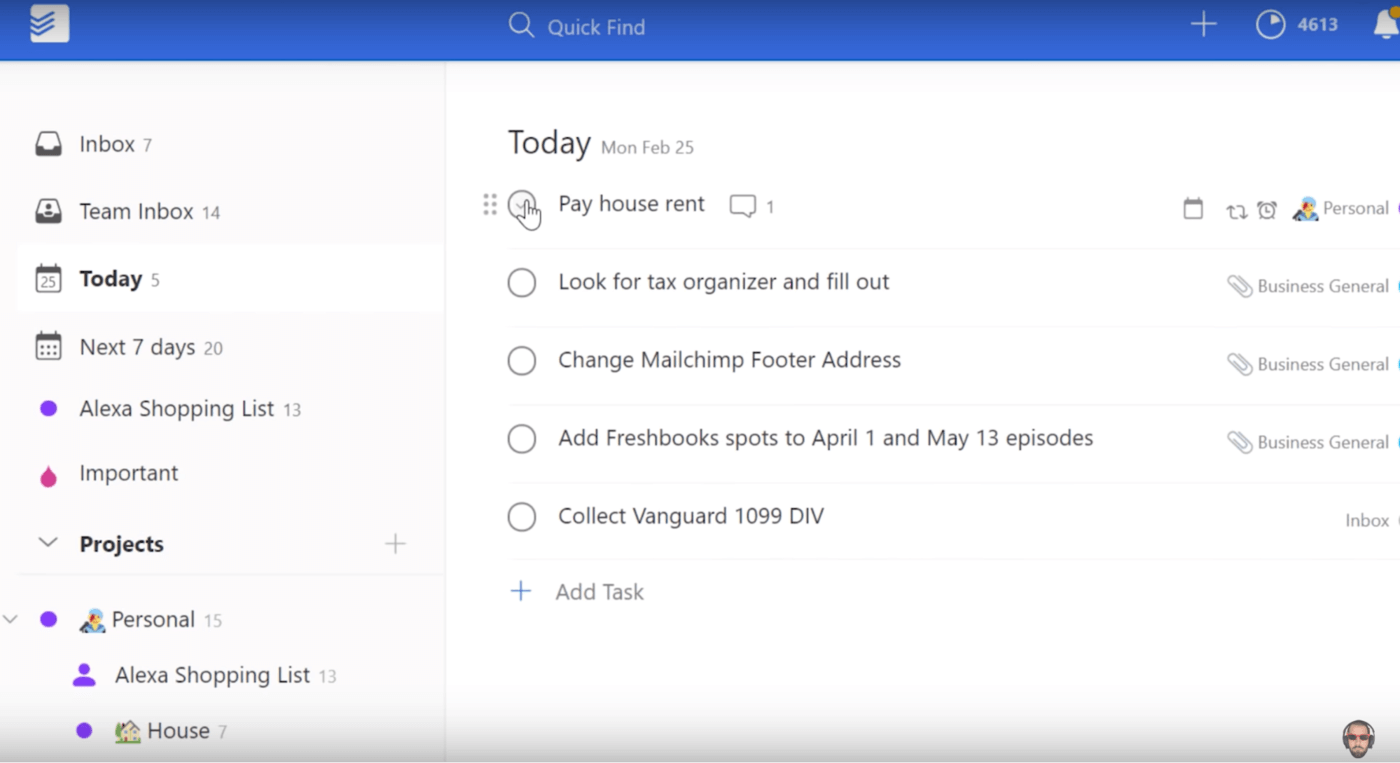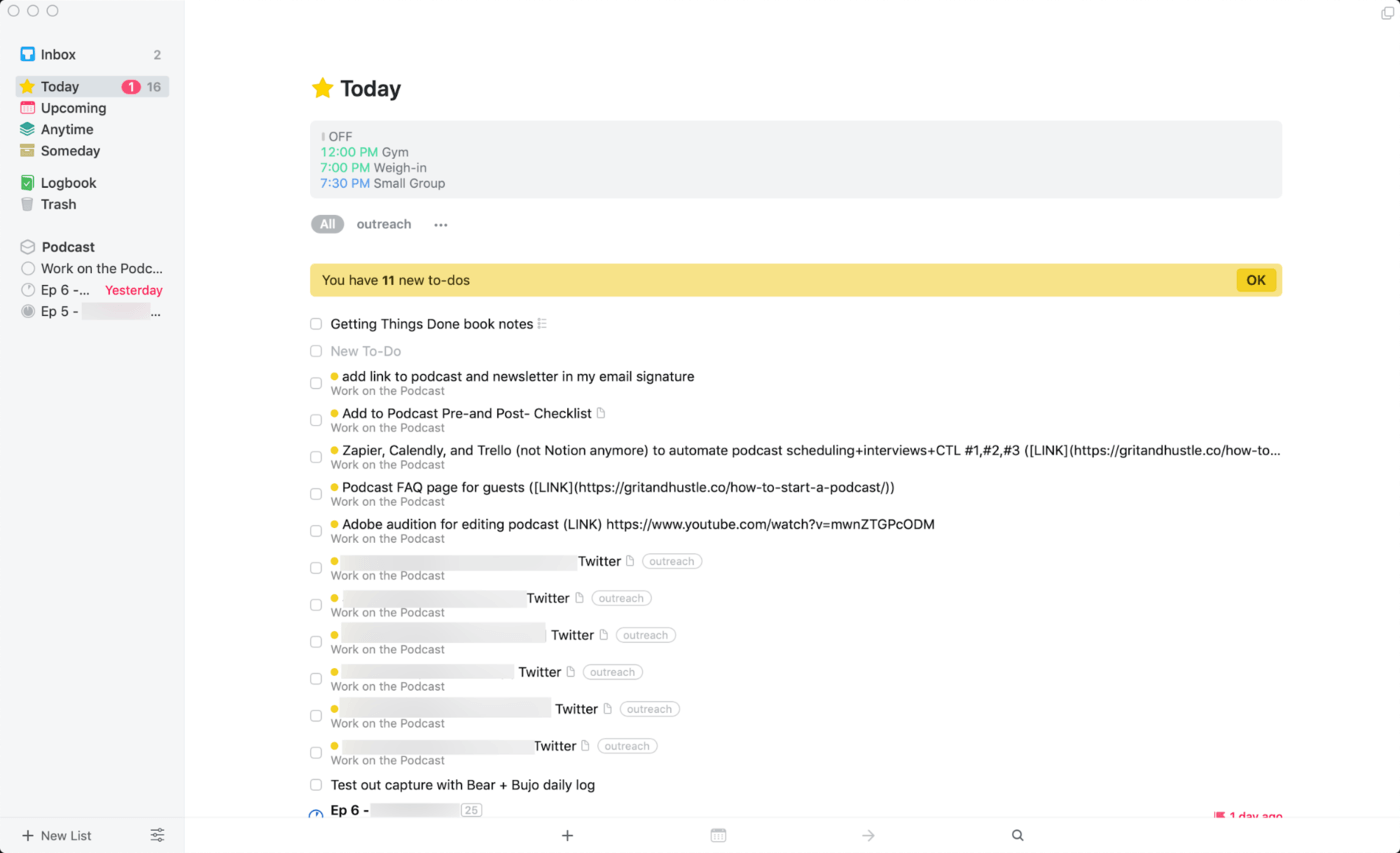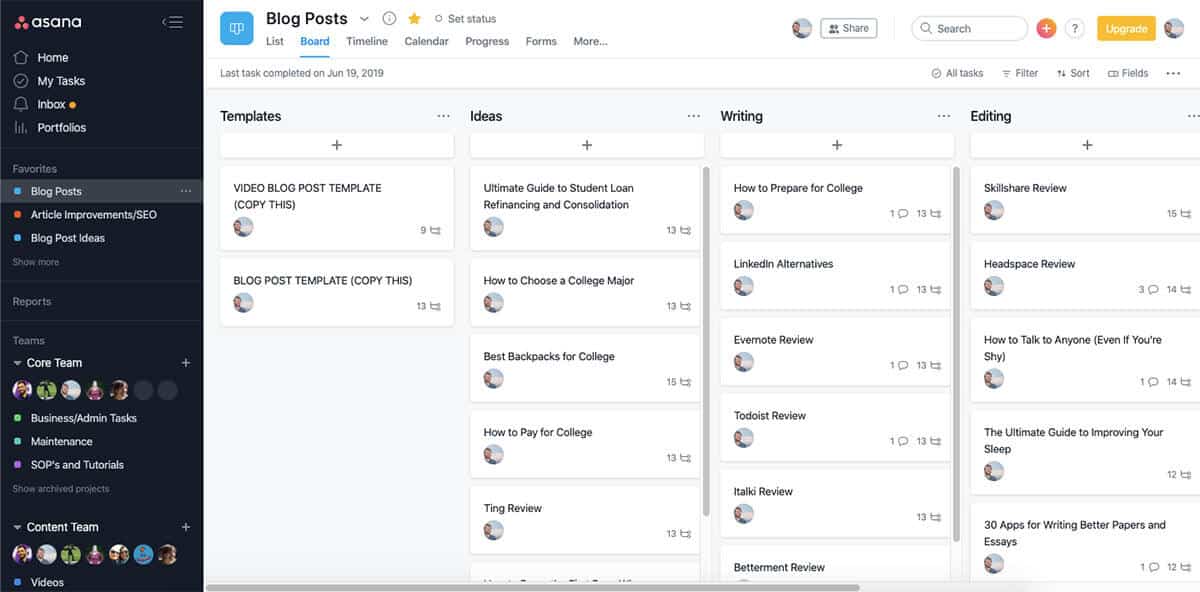Whether you’re a student or a professional, it can be tricky to stay on top of all the things you have to do. If you let all this information swirl around in your head, you’ll end up stressed and frantic.
There is a solution, however: use an external system. When you take your to-do list out of your head and into the right app, you’ll free up your brain to spend more time on important tasks and less time trying to remember that one thing you were supposed to do.
Choosing the right app can be tricky, however, which is why we’ve done the work for you. Below, we review the 10 best to-do list apps of 2023 – including pros and cons for each. This way, you can spend less time researching and more time being productive!
Todoist

Overview: Todoist combines a minimalist interface with powerful tagging and natural language processing features.
Pros
- Best app for natural language processing. Categorize tasks with due dates, tags, and projects while you type as fast as you think. No other app beats Todoist in this category.
- Sweet spot between power and flexibility. With projects, labels, filters, and priorities, you can tailor Todoist to your personal workflow, all while being intuitive to pick up and use.
- Quick add from everywhere. Todoist lets you add tasks from pretty much anywhere you can be online. In addition to being available on all the mobile app stores, Todoist has native apps on both Windows and Mac, a Chrome extension, and integrations with Gmail and Outlook.
Cons
- Windows app isn’t as good as the Mac app. This probably applies to a lot of apps. But the UI for Todoist’s Windows app doesn’t work quite as well as the mobile or Mac apps.
- Creating custom views or lists takes some work. Todoist has a built-in Today and Next 7 days view, but if you want to see your school tasks due the next week without worrying about the tasks for your part-time job, then it’ll take some fiddling with Todoist’s filters.
Price: Free (limited features). Upgrade to Pro for $36 / year to get additional file uploads, unlimited activity history, and more.
Platforms: Android, iOS, Mac, Windows, Web
Curious how your to-do list app fits into a larger productivity system? Check out this guide to staying organized in college.
TickTick

Overview: TickTick is quite similar to Todoist, with a nearly identical interface. It does offer some features that Todoist lacks, such as a built-in Pomodoro timer and calendar view.
Pros
- Cheaper than Todoist (for almost-equal functionality). TickTick positions itself as a direct competitor to Todoist. At $27.99 a year it delivers most of Todoist’s features, plus some things Todoist doesn’t have such as custom views (a.k.a. smart lists) and a built-in calendar view.
- Lots of delightful productivity extras. TickTick has a built-in Pomodoro timer that ties to specific tasks. The app also lets you add a new task to the beginning or the end of a list, as well as set start times and due dates. It even has a habit tracker and a white noise generator on mobile.
- “Plan My Day” feature. Pulls up tasks with due dates on them to help you decide what to work on for the day.
Cons
- No free calendar sync. You’ll have to get the premium plan and fiddle with links to sync your current calendar with TickTick.
- Limited free plan. The free plan limits you to 9 lists, 99 tasks per list, and 19 subtasks per task. This is probably enough for most people, but it could be an issue if you need to manage larger projects.
Price: Free (limited features). $27.99 / year gets you access to premium features such as filters, version history, and additional themes.
Platforms: Android, iOS, Mac, Windows, Web
Microsoft To Do

Overview: If you’re looking for the best to-do list app to use with other Microsoft apps, then Microsoft To Do is a great choice.
Pros
- Free. To Do is the first free app we’ve discussed so far. None of the more “advanced” features such as reminders or calendar sync require a paid subscription (unlike Todoist or TickTick).
- Subtasks work well. Microsoft To Do turns subtasks into “Steps” (basically a checklist) for a parent task. Each step can have its own due dates and notes.
- “My Day” feature. This feature is similar to other apps that automatically organize your to-do’s for today into one place. The difference is that Microsoft To Do’s “My Day” view starts empty and lets you manually add tasks to the list.
- Quick Add widget in Android notification. Good for capturing tasks quickly. (At least on Android).
Cons
- No tags, filters, and smart lists. For organization, Microsoft To Do lets you make separate lists, but other than that, there’s no way to tailor the app to your current workflow.
- Outlook-only calendar integration. I’m willing to bet my 5 internships that unless you work at a big company, you don’t use Outlook. Which means you’ll want a Google or Apple Calendar integration. Which you won’t get with this Microsoft app.
Price: Free
Platforms: Android, iOS, Mac, Windows, Web
Google Tasks

Overview: Google Tasks is a no-frills to-do list app that works perfectly with other Google apps (particularly Gmail and Google Calendar).
Pros
- Google. Tasks’ strength relies on its integration with Google’s suite of apps. For example, using Tasks on mobile or the web is great for quick capture, especially if you get a lot of tasks via Gmail.
- Best Google calendar view. Seeing, checking off, and updating my tasks for each day as I’m flipping through my Google Calendar is a time-saver. If you add a time to the task, it’ll even show up within your agenda and block off that time for you.
- Subtasks. Great for batching like tasks and then scheduling them all into one afternoon. Unlike more powerful apps, though, subtasks in Google Tasks don’t function as individual ones (e.g., you can’t set due dates for subtasks).
Cons
- Limited recurring tasks. Tasks won’t let you create recurring tasks containing subtasks. This means recurring tasks are limited to simple actions without multiple steps.
- Limited organization. Tasks only lets you sort to-do items manually or by due date. This makes it easy to just add tasks and then never complete them.
Price: Free
Platforms: Android, iOS, Web
Notion
Overview: Notion is a highly flexible app for managing your to-do list, writing documents, and organizing large volumes of information.
Pros
- Customizable layout. Notion lets you format your to-do list however you want. Choose everything from a simple checklist to a multi-column kanban board.
- Powerful organizational features. While it looks simple enough on the surface, Notion’s combo of databases and filters lets you create task management workflows suitable for complex projects.
- Active community. If you need a template for your next Notion project, someone in the community has probably created it. Ditto for Notion tutorials and third-party app integrations.
Cons
- A bit of a learning curve. While Notion is very powerful, expect to spend some time learning how to use it. Particularly in comparison to other to-do list apps, Notion’s interface takes some getting used to.
- Too complicated for some users. Notion thrives when you need to organize large amounts of information. If you just need to manage a simple set of personal tasks, many Notion features can be unnecessary.
Price: Free (5MB file upload limit). Upgrade to the Personal Pro plan ($5 / month) to get unlimited file uploads. Students and educators can get the Personal Pro plan for free.
Platforms: Android, iOS, Mac, Windows, Web
Want to learn how to manage your tasks in Notion? Check out our free template:
With a bit of work, Notion can be a capable task management app – and this template does the heavy lifting for you. Quickly add tasks to the Inbox, manage your day or week with the Today and Next 7 Days views, add sub-tasks and recurring tasks, and even run huge projects with Trello-style board views.
WorkFlowy

Overview: If you just need an app that will let you make lists and check things off, WorkFlowy is an excellent solution.
Pros
- Roll-up feature. WorkFlowy is the original bullet-list app with its core roll-up feature for sub-bullets. All you have to do is click a bullet and all the sub-bullets beneath it collapse into the higher one.
- Quick capture. WorkFlowy is great for capturing and outlining thoughts during brain dumps. It doesn’t force you to pick between adding subtasks or notes. Just dump ‘em all in there and decide later.
- List sharing. WorkFlowy has powerful sharing permissions that let others view or edit a shared list…even if they don’t have a WorkFlowy account.
Cons
- Just lists stuff, and doesn’t help you do stuff. WorkFlowy is great at managing lists, period. But if you’re looking for traditional to-do list app features such as due dates. WorkFlowy won’t be for you.
- The free plan is limited to 250 lists or items per month. This shouldn’t be a con because developers need to make money, too. But if you’re managing a lot of tasks, it could be an issue.
Price: Free (limited features). Upgrade to Pro ($4.99 / month) to get unlimited bullets and unlimited file uploads. University students and faculty can get a year of WorkFlowy Pro for free.
Platforms: Android, iOS, Linux, Mac, Windows, Web
ClickUp

Overview: ClickUp is a great app to use if you like being able to visualize tasks and projects in many different ways.
Pros
- Tons of ways to view and manage tasks and projects. There’s a list view, a kanban board view, a calendar view, and a Gantt chart view (a.k.a. timeline). There’s time tracking, subtasks, due dates, recurring tasks, and even a “Watcher” function (so you can see if your team member actually did their part of the project).
- Checklists. You can automagically generate templates for recurring tasks. This way you can stop forgetting that your liberal arts class’s semi-weekly essay uses MLA, not APA.
- Notepad feature. This is great for scratch notes, including a Chrome extension to get screenshots and add them to tasks.
Cons
- Friction in capturing and processing new tasks. It takes a lot of upfront thinking to figure out where tasks should go/be categorized, especially when you’re rushing out the door to your next class.
- Overkill for many people. Many of ClickUp’s features focus on collaboration and team productivity. If you just need an app to manage your personal tasks, then a lot of these features can be unnecessary.
Price: Free (limited to 100MB of storage). For $5 / month, you can get unlimited storage (and more) with ClickUp’s Unlimited plan.
Platforms: Android, iOS, Linux, Mac, Windows, Web
Things

Overview: If you need a to-do list app that can help you manage large, complex projects, Things is a great option.
Pros
- Most intuitive to-do app. Things was designed with the messy human brain in mind. For example, it lets you drill down your life from high-level areas and projects, all the way down to nitty-gritty checklists for items within tasks.
- Task templates. Task templates are an essential but neglected feature, especially for those of us who have recurring projects with similar requirements every week.
- Repeating projects. With Things, you can set recurring start dates for tasks or projects that automatically populate the page with everything you have to.
Cons
- Limited calendar integration There’s no native calendar integration aside from Apple’s. You can still sync your third-party calendar to your Apple Calendar as a workaround, but it’s not ideal.
- Separate purchases for Mac, iPhone, and iPad apps. While the lack of a recurring subscription is refreshing, you’ll need to purchase the Things app for each of your Apple devices.
Price:
- Mac: $49.99
- iPhone/Apple Watch: $9.99
- iPad: $19.99
Platforms: iOS, Mac
OmniFocus

Overview: A to-do list app based on the Getting Things Done (GTD) approach to productivity.
Pros
- Tailor-made for GTD. OmniFocus closely follows David Allen’s Getting Things Done philosophy. If you want an off the shelf app for implementing this system, nothing compares to OmniFocus
- Review perspective/view. For every project, you can input custom review intervals or just stick with your default project review cycle.
- “Defer until” feature. Most to-do list apps let you assign due dates, OmniFocus included. But OmniFocus also lets you “defer” tasks, essentially assigning a “start date.” This is useful for tasks that you can’t start until a specific date or time.
Cons
- Steep learning curve. I test drove OmniFocus and Things simultaneously and found myself picking up Things more quickly. Learning OmniFocus gave me a huge headache that lasted for a day.
- Apple-only ecosystem. Similar to Things, there’s no 3rd party calendar integration aside from Apple’s.
- No free plan. While OmniFocus does offer a free trial, you’ll need to pay to keep using the app.
Price: $9.99 / month (after a 14-day free trial)
Platforms: iOS, Mac
Asana

Overview: Asana is a robust to-do list and team productivity app. While it’s designed to help teams manage large projects, you can also use it to wrangle your personal tasks.
Pros
- Choice of kanban or list view. Asana gives you the flexibility to visualize your tasks the way you want. If you’re more of a visual thinker, then you can arrange your tasks in kanban-style columns. But if you prefer a traditional list-based view, Asana offers that as well.
- Effective for organizing large numbers of tasks. If you have lots of different projects going on, Asana makes it easy to keep them all organized. You can break projects down into tasks, which you can then further break down into subtasks.
- Comments to keep track of your progress. Asana lets you leave comments on any task you’re working on. While this is meant to help teams stay up to date, it’s also an effective way to leave notes to yourself.
Cons
- Can be overkill for individuals. Much like ClickUp, Asana shines when you use it with a team. If you’re just keeping track of your personal tasks, many of the communication and collaboration features in the app are unnecessary.
- Interface can get cluttered. While Asana is great for managing large, complex projects, the interface can get cluttered and difficult to navigate if you aren’t diligent about keeping tasks updated.
Price: Free (for individual use)
Platforms: Android, iOS, Mac, Windows, Web
Start Crossing Items Off Your To-Do List
Whatever your to-do list needs, I hope this guide has helped you find the right app.
Above all, remember that a to-do list app is just a tool. The best to-do list app, therefore, is the one that helps you accomplish your goals.
Want to learn about even more tools to help do your best work? Check out our guide to the best productivity apps.
Image Credits: notebook checklist



